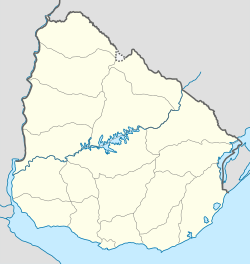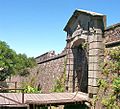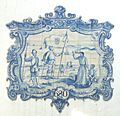Colonia del Sacramento facts for kids
Quick facts for kids
Colonia del Sacramento
Portuguese: Colônia do Sacramento
|
|
|---|---|
|
Capital city
|
|
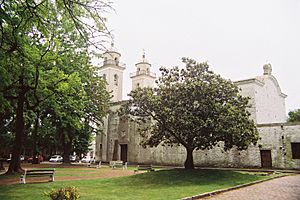
|
|
| Country | |
| Department | |
| Founded | 1680 |
| Founded by | Manuel Lobo |
| Elevation | 27 m (89 ft) |
| Population
(2011 Census)
|
|
| • Total | 26,231 |
| Time zone | UTC -3 |
| Postal code |
70000
|
| Dial plan | +598 452 (+5 digits) |
| Climate | Cfa |
| Website | https://www.colonia.gub.uy/ |
| UNESCO World Heritage Site | |
| Official name | Historic Quarter of the City of Colonia del Sacramento |
| Criteria | Cultural: iv |
| Inscription | 1995 (19th Session) |
| Area | 16 ha |
Colonia del Sacramento is an old city in southwestern Uruguay. It sits right by the Río de la Plata, a wide river that separates Uruguay from Argentina. Across the river, you can see Buenos Aires, Argentina's capital. Colonia del Sacramento is one of the oldest towns in Uruguay. It is also the main city of the Colonia Department. About 27,000 people live there.
The oldest part of the city, called the historic quarter, is very special. It is a UNESCO World Heritage Site. This means it is protected because it is important to the world's history and culture. Today, Colonia del Sacramento makes textiles (like clothes). It also has a special free trade zone for business. There is a polytechnic center and many government buildings.
Contents
History of Colonia del Sacramento
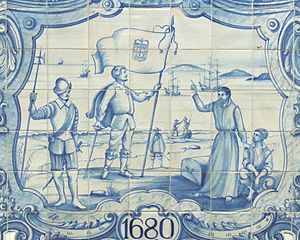
Colonia del Sacramento has a long and interesting history. It was often fought over by Portugal and Spain. Both countries wanted to control this important area.
How the City Began
In 1680, King Peter II of Portugal wanted to set up a new settlement. He sent a man named Manuel Lobo with five ships. They had about 400 soldiers and workers. On January 28, 1680, they started building a new town. They called it Colónia do Sacramento.
Spain did not like this. José de Garro, a Spanish leader, sent his soldiers. On August 6, 1680, they captured the new town. Lobo was taken prisoner. But in 1681, a treaty was signed. This treaty gave Colonia back to Portugal.
Portuguese Rule and Growth
In 1683, the Portuguese came back and rebuilt the town. They started to make it stronger. The main ways people made money were by smuggling goods and hunting cattle. The governor, Dom Francisco Naper de Lencastre, ordered new stone houses. He also made the city walls bigger. People grew wheat and grapes. They sent cattle hides to Brazil and brought in wood and food.
Wars and Changes of Control
Colonia was attacked many times. In 1704, during the War of the Spanish Succession, the Spanish attacked again. The Portuguese had to leave in 1705. Most of the town was destroyed.
But the Treaty of Utrecht in 1713 gave Colonia back to Portugal. Manuel Gomes Barbosa arrived in 1718 with many new settlers. Antonio Pedro de Vasconcellos became governor in 1722. He made Colonia a very rich and well-defended city. He built strong forts along the coast.
Another Spanish attack happened between 1735 and 1737, but it failed. In 1762, the Spanish leader Pedro Antonio de Cevallos forced the Portuguese to surrender. But the Treaty of Fontainebleau in 1762 returned Colonia to Portugal again.
Finally, in 1777, the First Treaty of San Ildefonso made Colonia a Spanish possession for good.
Later History
After being Spanish, Colonia became part of Portugal again. Then, in 1816, it became part of Brazil. This was when all of Uruguay was taken over by Brazil.
In 1809, before Uruguay became independent, Colonia was called a "Vila" (town). Later, it became a "Ciudad" (city).
Since Uruguay became independent, Colonia del Sacramento has grown. The newer parts of the city have straight streets. But the old historic quarter still has its winding streets. These streets were built by the Portuguese to fit the land.
A New City for the Future
In 2022, there were plans to build a new city near Colonia. It would be called Colonia Ala Este. This new city would be like Silicon Valley in the USA. It would attract people from Argentina who are looking for new opportunities. The plan is to double Colonia's population to about 60,000 people. This new city would focus on technology and knowledge-based jobs. It would be built on a large area with forests and beaches.
Who Ruled Colonia?
Colonia del Sacramento changed hands many times. Here is a quick look at who ruled it:
| From | To | Rule | Reason for Handover |
|---|---|---|---|
| 1680 | 1680 | conquered by José de Garro | |
| 1680 | 1681 | treaty between Spain and Portugal | |
| 1681 | 1705 | conquered in the War of Spanish Succession | |
| 1705 | 1713 | Treaty of Utrecht | |
| 1714 | 1762 | First Cevallos expedition | |
| 1762 | 1763 | Treaty of Paris (1763) | |
| 1763 | 1777 | Second Cevallos expedition | |
| 1777 | 1811 | Revolt led by José Gervasio Artigas | |
| 1811 | 1817 | Portuguese conquest | |
| 1817 | 1822 | United Kingdom of Portugal, Brazil and the Algarves | Brazilian Declaration of Independence |
| 1822 | 1828 | Cisplatine War | |
| 1828 | present |
Population of Colonia del Sacramento
In 2011, Colonia del Sacramento had 26,231 people. The city has grown a lot over the years.
| Year | Population |
|---|---|
| 1908 | 8,021 |
| 1963 | 12,846 |
| 1975 | 17,046 |
| 1985 | 19,102 |
| 1996 | 22,200 |
| 2004 | 21,714 |
| 2011 | 26,231 |
Source: Instituto Nacional de Estadística de Uruguay
Geography and Climate
Colonia del Sacramento is built on a piece of land that sticks out into the Río de la Plata.
Climate
The city has a mild humid subtropical climate. This means it has warm summers and cool winters. Sometimes there are frosts and fog. Rain falls evenly throughout the year. The average yearly temperature is about 17 °C (63 °F).
City Layout
The oldest part of the city, called the "Barrio Histórico" (Historic Quarter), is 16 hectares big. It used to be surrounded by a strong wall. Most of this wall was removed over time. The streets in this old part are not straight. They follow the shape of the land, which was how the Portuguese built them.
Outside the old wall, the rest of the city was planned by the Spanish. This part has a more common checkerboard pattern of straight streets.
Sports in Colonia del Sacramento
Colonia del Sacramento has a few sports teams.
- Plaza Colonia is a professional football (soccer) team. They were founded in 1917. They play at the Estadio Profesor Alberto Suppici. In 2016, they won a big championship, which was their best success.
- Deportivo Colonia was another football team, founded in 1999. They stopped being a professional team in 2007. They play at the Estadio Miguel Campomar.
- Club Atlético Plaza has teams for futsal (indoor soccer), volleyball, and basketball. They also have a football section.
The city also has an old bullring. It is no longer used for bullfighting. Instead, it has been fixed up to be a place for concerts and shows.
Cool Places to Visit
The Barrio Histórico (historic quarter) is a World Heritage Site. It has many old cobblestone streets built by the Portuguese. You can easily walk there from the ferry terminal. Here are some interesting places to see around the main square, Plaza Mayor:
- Portón de Campo – This is the old City Gate with a wooden drawbridge.
- Lighthouse and convent ruins – You can see the ruins of a 17th-century convent and climb the lighthouse for great views.
- Basílica del Santísimo Sacramento – This church was built by the Portuguese in 1808 using stone.
- Portuguese Museum – This museum is in an 18th-century building. It shows Portuguese furniture, jewelry, uniforms, and old maps.
- Casa de Nacarello – An old Portuguese house from the 18th century.
- Calle de los Suspiros – This is a famous historical street, often called "Street of Sighs."
- Municipal Museum – This building was rebuilt by the Spanish in 1835. It shows items and papers from the city's different time periods.
- Viceroy's House – The Casa del Virrey has been rebuilt from its original ruins.
- Plaza de toros Real de San Carlos – This is the old bullring, now used for events.
Gallery
- Views of the ''Barrio Histórico''
Getting Around
Colonia del Sacramento is easy to reach.
- Ferry Boats: Three ferry lines connect Colonia to Buenos Aires, Argentina. They are "Buquebus," "Seacat Colonia," and "Colonia Express."
- Highways: Two main roads end in Colonia. Route 1 goes to Montevideo and places to the east. Route 21 goes north, including to the Aarón de Anchorena National Park, which is about 30 km (19 mi) away.
- Airport: The city has a local airport called Laguna de los Patos International Airport. It is about 6 km (4 mi) from Colonia. There are plans to make the runway longer for more flights.
Consulates
Argentina and Portugal both have a consulate in Colonia del Sacramento. A consulate is like a small office that helps citizens from their country who are visiting or living there.
See also
 In Spanish: Colonia del Sacramento para niños
In Spanish: Colonia del Sacramento para niños


